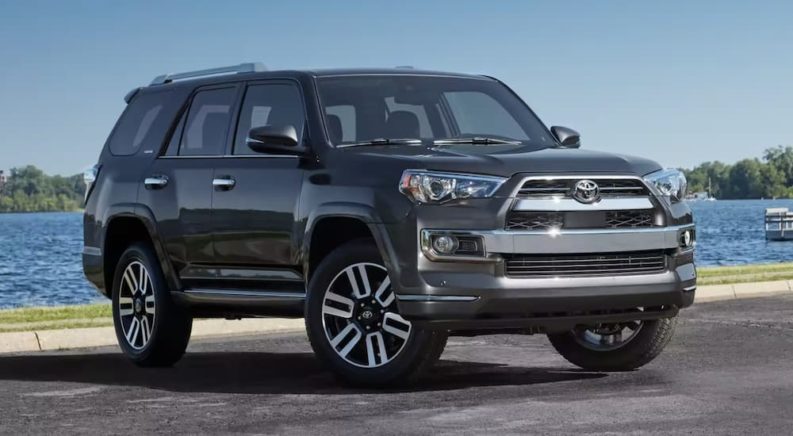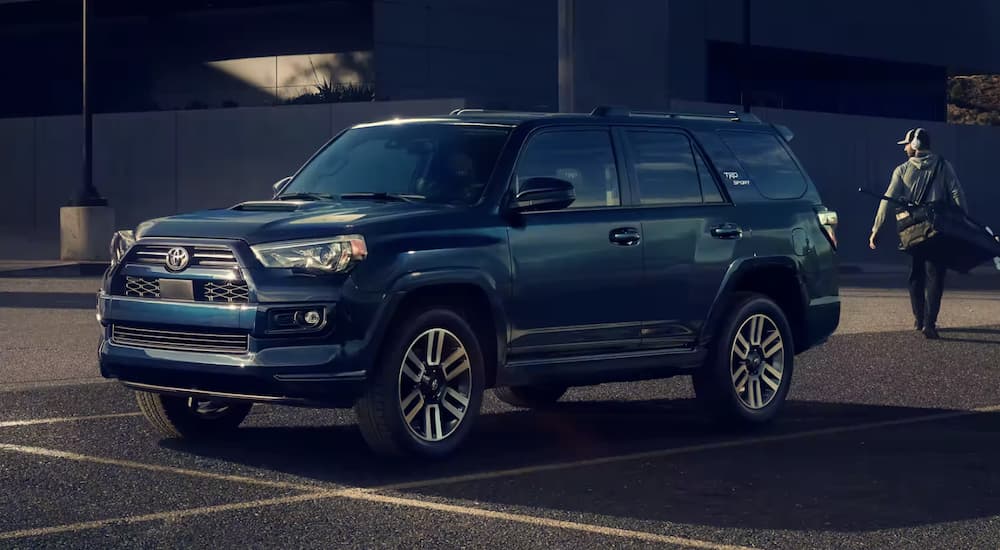Take a quick look around the country’s highways and byways, and one thing will become clear: SUVs are the king of the road. The category has only risen in popularity since its introduction in the late 70s, with today’s crossovers craze fueling a new wave of SUV excitement. While these smaller, more nimble alternatives to the more traditional, truck-like body-on-frame SUVs of old, they lack some of the raw power and capability of their forerunners. Renowned for their rugged performance and off-road credentials, body-on-frame SUVs have remained a popular choice for drivers who demand a little more out of their vehicles. The same attributes that allow these SUVs to perform so well in off-road environments also go a long way in helping the vehicles to retain their value, though not all old-school SUVs are equal in that regard.
First introduced in 1984, the Toyota 4Runner is true to its name and the living embodiment of the phrase “They don’t make them like they used to.” There’s a reason that any Toyota 4Runner for sale doesn’t stay on the market for long. With a hardy and powerful body-on-frame design, refreshingly minimalist approach, and lengthy off-road resume, the 4Runner is a perennially popular model that’s defied many of the market’s flash-in-the-pan trends to deliver a consistent product that’s earned a loyal following.
That’s not to say that the 4Runner hasn’t kept up with the times; it’s simply that Toyota hasn’t had to pull out a whole bag of tricks to retain consumer interest over the years. Four-wheel drive, outstanding reliability scores, and generous cargo room have made the mid-size 4Runner a staple of the off-roading scene and, more importantly, allowed the SUV to become one of the best values in its class with a resale value that no other model can touch.
The 2022 4Runner, for example, leads all SUVs with a resale value of 58 percent, significantly higher than the SUV average of 48.7 percent. The 4Runner is even notable compared to off-road-capable SUVs like the Ford Bronco Sport (57.8 percent). The gulf in depreciation is even more pronounced when you start examining some of the 4Runner’s closest competitors in the crossover market. Relative newcomers like the Kia Telluride and Subaru Crosstrek can’t touch the Toyota model, with resale values of 51.9 percent and 52.3 percent, respectively. So what makes the Toyota 4Runner such a great value? Let’s dive into some of the SUV’s background and examine how it does such an outstanding job of maintaining its value.
The 4Runner’s Forerunner
The 4Runner can trace at least some of its popularity on the market to its longevity. A force to be reckoned with for over 35 years, Toyota’s mid-size SUV has been around long enough to earn a reputation as a reliable off-road beast that can perform just as well on the highway or crowded city streets. Of course, that hasn’t always been the case. The 4Runner started as a compact SUV that was basically a Toyota Helix pickup with a new fiberglass shell fitted over the bed. Modeled after other early SUVs like the Ford Bronco and Chevy K5 Blazer, the early 4Runner lacked much of the heavy-duty construction found on later models.
For example, Toyota didn’t upgrade the rear springs found on the Helix to accommodate the rear seats and fiberglass top, causing the rear suspension of these fledgling 4Runner to develop a telltale sag. That’s not to say the first-generation 4Runner didn’t show some signs of its impending greatness. Toyota swapped the solid front axle for an independent suspension midway through the first generation, enhancing the SUV’s off-road profile and endearing itself to a new generation of off-road enthusiasts.
The 4Runner grew into its own in subsequent generations. The second-gen 4Runner, introduced in 1990, got a new full-steel integrated body and upgraded the suspension with a new coil spring approach. In the third generation, Toyota introduced a refined chassis that gave the 4Runner a more road-worthy appearance, lengthening the wheelbase and redesigning the interior with a focus on ergonomics and space. These changes improved the SUV’s appeal for those drivers who were less likely to explore the 4Runner’s off-road side.
This continued into the fourth generation as the automaker continued to round out the 4Runner’s hard edges for a more car-like appeal, but power and off-road performance were never an afterthought. The fourth-gen 4Runner was the first to receive a V8 with an optional 4.7-liter engine producing 235 hp and 320 lb-ft of torque. One of just five engine options available for the 4Runner, the V8 was a valuable addition to the lineup alongside the standard 4.0-liter V6.
That brings us to the current 4Runner, the fifth-generation model that hit the market back in 2009. It’s a notably long lifespan for any model, but this speaks to the 4Runner’s long-standing popularity among drivers seeking a reliable yet fun mid-size SUV. Introducing new generations of a vehicle is often a cheap way for automakers to drum up sales, but with the 4Runner’s reputation, such marketing tricks are hardly necessary. The most recent generation has doubled down on the SUV’s off-road credentials, adding a new Kinetic Dynamic Suspension System (KDSS).
It also came equipped with a rear locking differential and innovative crawl control feature that had previously only been available on some premium Toyota models. Crawl Control can detect challenging driving conditions and automatically adjust the throttle and brakes, allowing drivers to focus on navigating the road ahead. This is particularly useful in conditions like loose sand, where it’s easy for drivers to sink in if they don’t manage their speed appropriately. The 4Runner has been sold with one engine since 2009, a 4.0-liter V6 with intelligent variable valve timing (VVT-i) producing 270 hp and 278 lb-ft of torque.
No mention of the fifth-generation 4Runner would be complete without touching on the TRD Pro trim. Introduced for the 2015 model year, this off-road-focused package added upgraded shocks, springs, tires, and skid plates to the SUV, allowing owners to drive straight from the dealership to their nearest off-road trials. Toyota took no half-measures when designing the TRD Pro model, loading it up with TRD Bilstein shocks with remote reservoirs and a host of additional high-end off-road equipment.
While the 4Runner has always been intended as a more spartan alternative to some of the more luxury-focused SUVs on the market, Toyota has made some concessions when it comes to safety and modern amenities. Starting in 2019, all 4Runners came standard with the Toyota Safety Sense P package, USB ports, Entune 3.0 infotainment system, touchscreen display, and 4G LTE internet access. 2021 saw the addition of a new smart key system with push-button start, LED fog lights and headlights, and blind spot monitoring with rear cross-traffic alert. The TRD Pro continues to innovate in the off-road sphere, adding a multi-terrain monitoring system that uses a network of cameras to give drivers a 360-degree view of their surroundings.
A Winning Formula
SUVs already outpace many other vehicle classes when it comes to value retention, with an average depreciation of 51.3 percent over a five-year period compared to 53.5 percent for cars. The 4Runner blows both these figures away and is truly in a class of its own when it comes to value retention, with an average 5-year depreciation of just 49.6 percent. The SUV is only outpaced by the industry’s two most slowly depreciating pickups, making the 4Runner an obvious choice for drivers looking to maximize their return on investment. The 4Runner is no anomaly. With a reputation for quality and reliability, Toyota has long been an industry leader in value retention, with the Tacoma pickup setting the standard with a five-year depreciation of just 29.2 percent.
So what makes the 4Runner so good at retaining its value? Simply put, it doesn’t have any real competition. As more and more automakers phase out traditional body-on-frame SUVs in favor of crossover models, Toyota has gone against the current when it comes to the 4Runner. The SUV’s heavy-duty construction, powerful V6 engine, 5-speed transmission, and famous Toyota reliability bring everything there is to love about the old-school pickup truck into an adventure-ready package that almost defies categorization.
That reliability plays a big part in the 4Runner’s ability to retain its value. The 2022 model has a 4-star reliability rating from Consumer Reports, but recent ratings aren’t always a great indicator of future performance. Looking back at the SUV’s recent history is a little more helpful with models like the 2008 4Runner earning an 86 out of 100 rating and a corresponding Quality & Reliability award from J.D. Power. More recently, the 2017 model took home an 88 out of 100 rating, making the five-year-old version a recent standout. Consumer Reports bases its reliability ratings on 17 potential trouble spots, and aside from a fuel system issue in certain 2019 models, recent 4Runners have all aced the test with no common severe issues to speak of.
With annual maintenance and repair costs of $514, the 4Runner is also cheaper to keep on the road than the average SUV, which costs, on average, $652. This low cost of ownership makes the 4Runner easy to maintain, and as such, it’s not uncommon to find used 4Runners on the market with more than 200,000 miles on the odometer. While this would usually be a red flag for drivers, the 4Runner’s reputation is such that the SUV often has plenty of life left in it well after passing that particular milestone.
While some might expect an off-road-ready SUV like the 4Runner to quickly lose value due to hard use, it’s actually the opposite. The same rugged components that make the SUV stand out in off-road environs allow it to withstand years of regular use without significantly sacrificing performance. The 2022 model is a great example of how this sort of heavy-duty equipment can work in a vehicle’s favor, with the TRD Pro model coming standard with a locking rear differential, Nitto Terra Grappler all-terrain tires, 17-inch alloy wheels, Bilstein shocks with remote reservoirs, selectable driving modes, and Kinetic Dynamic Suspension.
Ground clearance is key in any off-road rig, and the 4Runner delivers in that department with 9.6 inches of lift, a 33-degree approach angle, and a 26-inch departure angle. The 2022 model also sees the introduction of a new TRD Sport model. While not as full-function as the TRD Pro, the new trim impresses with 20-inch wheels, a hood scoop, and adaptive dampers that offer improved body control, a feature previously found only on the luxury-focused Limited trim.
As we mentioned, Toyota has improved the 4Runner’s profile as a family vehicle in recent years by integrating new infotainment, safety and convenience features with every new model year. The SUV’s biggest selling factor for families might just be its ample cargo room. A third-row seat is perfect for the kids, and when stowed, it ups the 4Runner’s cargo volume to an impressive 46.3 cu.ft. That figure rises to 88.8 cu.ft. with both rows folded, giving the 4Runner the sort of storage space that’s almost unrivaled in the mid-size class. A 5,000 lb towing capacity gives drivers all the power they need to tow along a boat, camper, or whatever else they might need for those weekend adventures making the 4Runner a well-rounded option for both thrillseekers and families alike.
The 4Runner Is a Worthy Investment
It’s hard to match the Toyota 4Runner regarding dependability, performance, and resale value. The SUV almost feels like a product of a different time, a time before every SUV felt it needed to downplay its sportiness and utility in favor of the car-like qualities that have proven so popular as of late. By going against the grain, Toyota has managed to offer something truly unique in today’s market, and if the SUV’s low depreciation is any indicator, something that drivers still desperately want.
Sure, it might not be packed with all the cutting-edge infotainment features and luxury touches of some of today’s glitzy crossovers, but many will see that as a fair trade-off for the sort of power, cargo space, and reliability that the 4Runner brings to the table. The 4Runner has come a long way since its humble beginnings as a capped version of the Helix pickup. While it’s sure to continue to evolve in the coming years, Toyota already has a winning formula with this fan-favorite SUV.






